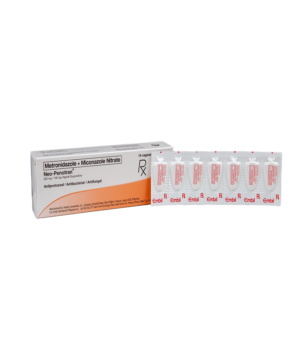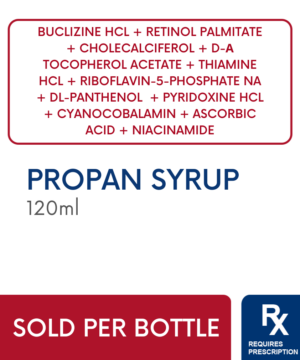Combivent Udv 2.5Ml
₱61.00
IMPORTANT NOTICE: We require a doctor’s prescription for this product. Don’t forget to attach a copy of your valid prescription (.jpeg, .pdf, or .png format) upon checkout, or email it to onlinesales@rosepharmacy.com with your order number! All online order are manually check by our online pharmacist, please expect a phone call for order validation after we receive your orders. For a smoother transaction upon delivery, please be ready to present the original copy of your prescription when claiming your order.
- Applicable for Metro Cebu order
- Credit Card, GCash, Maya, Bank Transfer and COD payment available
- Daily Operations - 8:00 AM to 6:00 PM
- Order Cut-off - 3:00 PM
- Free Shipping for 1,499 and above orders (Visayas & Mindanao)
- For Order below 1,499 delivery fee of 99.00 (less than 1 kilo) will be applied
- For Order below 1,499 delivery fee of 199.00 (1 -3 kilo) will be applied
- Credit Card, GCash, Maya and Bank Transfer payment available
- Description
- Reviews (0)
Description
Combivent Udv 2.5Ml
Description :
Each unit-dose vial (2.5 mL) solution for inhalation contains ipratropium bromide monohydrate 520 mcg corresponding to anhydrous ipratropium bromide 500 mcg and salbutamol sulfate 3.01 mg corresponding to 2.5 mg salbutamol base.
Ipratropium bromide is (8r)-3a-hydroxy-8-isopropyl-1aH,5aH-tropanium bromide (?)-tropate monohydrate while salbutamol sulfate is di[(RS)-2-tert-butylamino-1-(4-hydroxy-3-hydroxymethyl-phenyl)ethanol] sulfate.
Indications / Uses :
Management of reversible bronchospasm associated with obstructive airway diseases.
Contraindications :
Hypersensitivity to atropine, its derivatives or to any other component of Combivent UDV.
Patients with hypertrophic obstructive cardiomyopathy or tachyarrhythmia.
Special Precautions :
Immediate hypersensitivity reactions may occur after administration of Combivent UDV, as demonstrated by rare cases of urticaria, angioedema, rash, bronchospasm and oropharyngeal edema.
Ocular Complications: There have been isolated reports of ocular complications (ie, mydriasis, increased intraocular pressure, narrow-angle glaucoma, eye pain) when aerosolized ipratropium bromide, either alone or in combination with an adrenergic ?2-agonist, has escaped into the eyes.
Eye pain or discomfort, blurred vision, visual halos or colored images in association with red eyes from conjunctival congestion and corneal edema may be signs of acute narrow-angle glaucoma. Should any combination of these symptoms develop, treatment with miotic drops should be initiated and specialist advice sought immediately.
Patients must be instructed in the correct administration of Combivent UDV. Care must be taken not to expose the eyes to the aerosol or solution of Combivent UDV.
It is recommended that the nebulized solution be administered via a mouthpiece. If this is not available and a nebulizer mask is used, it must fit properly.
Patients who may be predisposed to glaucoma should be warned specifically to protect their eyes.
In the following conditions, Combivent UDV should only be used after careful risk/benefit assessment, especially when doses higher than recommended are used: Insufficiently controlled diabetes mellitus, recent myocardial infarction, severe organic heart or vascular disorders, hyperthyroidism, pheochromocytoma, risk of narrow-angle glaucoma, prostatic hypertrophy or bladder-neck obstruction.
Potentially serious hypokalemia may result from ?2-agonist therapy. Additionally, hypoxia may aggravate the effects of hypokalemia on cardiac rhythm.
Patients with cystic fibrosis may be more prone to gastrointestinal motility disturbances.
In the case of acute, rapidly worsening dyspnea (difficulty in breathing), a doctor should be consulted immediately.
If higher than recommended doses of Combivent UDV are required to control symptoms, the patient’s therapy plan should be reviewed by a doctor.
Use in pregnancy & lactation: The safety of Combivent UDV during human pregnancy is not established. The usual precautions regarding the use of drugs in pregnancy, especially during the 1st trimester, should be observed.
The inhibitory effect of Combivent UDV on uterine contraction should be taken into account.
Salbutamol sulfate and ipratropium bromide are probably excreted in breast milk and their effects on the neonate are not known. Although lipid-insoluble quaternary bases pass into breast milk, it is unlikely that ipratropium bromide would reach the infant to an important extent, especially when taken by inhalation. However, because many drugs are excreted in breast milk, caution should be exercised when Combivent UDV is administered to a nursing woman.
Be the first to review “Combivent Udv 2.5Ml”
You must be logged in to post a review.




















Reviews
There are no reviews yet.